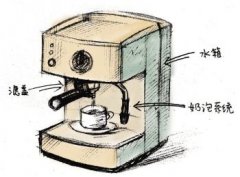Premium coffee beans recommend mocha coffee (Mocha Coffee)
Produced in Ethiopia. Beans are small and fragrant, with strong sour and mellow taste, moderate sweetness and special flavor. Washed coffee beans are well-known high-quality coffee, often drunk on a single basis. However, if mixed coffee can be blended, it is an ideal comprehensive coffee with ideal flavor.
Mocha coffee beans
Origin: Ethiopia (Ethiopia)
Baking method: CityRoast
Properties:
1. Taste: slightly sweet with soft acidity, sweetness has its unique round ripe taste and its unique sweetness, sour and bitter taste is extremely elegant.
2. Fragrance: full-bodied aromas of fruit and grass.
3. Vision: the bean granule is small and the bean color is uneven. Remarks show that Ethiopia, known as the birthplace of coffee, has a history of coffee origin and traditional agricultural countries, and is most famous for its "mocha-Mocha" coffee. In the West, Mocha is not only the name of the coffee variety, but also refers to the method of brewing coffee or the utensils for brewing coffee and special conditioning methods. Mocha coffee beans are mostly dried, but there are also so-called gourmet water-washed beans. Mocha beans are famous for their sour taste, slightly sweet, slightly alcoholic aroma and low caffeine content.
Also known as "Wicklana Coffee". Combining the sour and mellow flavor of mocha coffee with the sweetness of warm fresh milk and chocolate syrup, it has become the most popular drink for women.
Color: the acidity, aroma and mellow of mocha hot coffee blend with the sweetness of warm fresh milk and chocolate syrup, which is very suitable for women and people who are afraid of heavy caffeine.
Tip: pay attention to the proportion of added portions, fresh milk only needs to be warm.
Taste: sweet and mellow.
Ingredients: 1 cup of mocha hot coffee, 2 OZ of warm fresh milk, 2 OZ of chocolate syrup, right amount of fresh cream, a little sliced chocolate, sugar packet.
Procedure: 1 cup of mocha hot coffee is about 7 minutes full, add 2 OZ warm milk, 1 OZ chocolate syrup and stir, then rotate and add a layer of whipped cream, sprinkle with sliced chocolate chips and attach sugar packet. (OZ: ounces, 1OZ=28.41 milliliters)
Suitable time to drink: in the morning or after meal
Important Notice :
前街咖啡 FrontStreet Coffee has moved to new addredd:
FrontStreet Coffee Address: 315,Donghua East Road,GuangZhou
Tel:020 38364473
- Prev

Technology of making boutique coffee siphon pot brewing coffee
The siphon pot (Syphon), also known as the plug pot, always seems to remind people of the utensils of chemical experiments. However, because they are all glass containers, the whole cooking process is clearly visible, which is an excellent brewing method with excellent visual effect. In terms of taste, it is also the favorite of some coffee lovers. At the same time, the whole brewing process will be filled with a very charming aroma of coffee. So, what are you waiting for? I'm coming.
- Next

Coffee making technology A series of mocha pots for brewing coffee at home
Nowadays, more and more people like to drink coffee, and with the gradual popularity of coffee culture, many people begin to try to buy their own coffee beans and coffee utensils to brew coffee at home, which is both hands-on and an attitude towards life. However, at the beginning of learning to make coffee, we will always encounter this or that problem. In order to help readers who want to simply brew coffee at home, this page will be irregular from this issue.
Related
- Beginners will see the "Coffee pull flower" guide!
- What is the difference between ice blog purified milk and ordinary milk coffee?
- Why is the Philippines the largest producer of crops in Liberia?
- For coffee extraction, should the fine powder be retained?
- How does extracted espresso fill pressed powder? How much strength does it take to press the powder?
- How to make jasmine cold extract coffee? Is the jasmine + latte good?
- Will this little toy really make the coffee taste better? How does Lily Drip affect coffee extraction?
- Will the action of slapping the filter cup also affect coffee extraction?
- What's the difference between powder-to-water ratio and powder-to-liquid ratio?
- What is the Ethiopian local species? What does it have to do with Heirloom native species?

